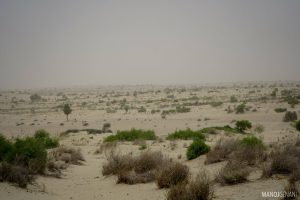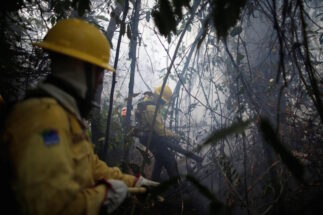Lawyer Owais Awan is elated at the decision of the Islamabad High Court (IHC), which ruled this May that a distressed Asian elephant called Kaavan should be moved to Cambodia from Marghazar Zoo in Islamabad.
“We were lucky to have a judge who was receptive and passionate about the cause of animal welfare,” said Awan.
Kaavan was gifted to the Pakistani government by Sri Lanka in 1985, when he was a year old.
“My children and even my grandchildren grew up seeing Kaavan and it will be sad to see him off, but we all know he has a beautiful future ahead of him; he will be at peace,” said Anis ur Rahman, the chair of the Islamabad Wildlife Management Board (IWMB).
Kaavan will be shifted to a sanctuary in Cambodia before September and the board has been ordered by the court to take over the management of Marghazar Zoo as well as oversee the safe relocation of Kaavan.
The judge also instructed that all the 878 other animals held in Islamabad’s zoo be relocated within 60 days of the order.
The ruling was celebrated with enthusiasm in Pakistan and by Kaavan’s campaigners across the world. But it has also forced many to question the value of such zoos – especially with dozens of incidents of abuse reported across cities in Pakistan.
See: First rescued snow leopard cub in India returns to mother
See: Bear’s ‘nationality’ sparks debate in Nepal
The elephant that sparked a campaign
A report submitted to the court details the problems with Kaavan’s treatment and was referred to in the judgement. It states that the elephant lives in conditions “inappropriate” to meet his “physiological, social and behavioural needs”. As well as being regularly chained up in a small enclosure, he has been kept in isolation since 2012. His food is “substandard” and “inadequate”, and his mahouts, or keepers, have a “negative relationship” with him.
In 2015, a student called Samar Khan started an online petition, bringing the world’s attention to the elephant’s plight.
Describing his release as “almost surreal”, Khan, who is now a vet, recalled her campaign. “His suffering spoke to a lot of people, and he grew a very passionate fan base, with people protesting outside Pakistani embassies,” she told The Third Pole.
She then created a Facebook page sharing Kaavan’s story.
The vet said she believed social media was a powerful tool. It allowed people from all over the world to come together and “hold the zoo officials accountable.”
“People held tweetstorms tagging celebrities. We made a template email and had hundreds of people use it to send letters to government officials every day,” she recalled. Cher, the American pop singer, was among those who joined the campaign.
Cher’s organisation, Free the Wild, will now fund the relocation, said Anis ur Rahman.
“The process is complex and involves a huge amount of paperwork. After that, specialist vets will assess whether Kaavan is physically and mentally fit for the flight. If all that is cleared, a steel cage will be constructed and Kaavan trained to go into it – which could take two to four weeks.”
Challenges ahead
Even as many celebrate Kaavan’s impending freedom, Uzma Khan, the director of biodiversity at WWF Pakistan, is sceptical. She was among those who gave evidence to the court on the case and said transportation can cause huge stress in an animal. “God forbid something happens during this transfer, who will take responsibility?” she said.
Uzma Khan also expressed concern about whether Kaavan will adjust to his new life, saying, “Considering the average zoo life expectancy of an Asian elephant, Kaavan has lived most of his life, and efforts should be made to improve his enclosure and provide enrichments so that his quality of life improves and he is more active.”
The average lifespan of Asian elephants in captivity is 47.6 years in Europe and 41.9 years in North America; they can live up to 60 years in the wild. Classified as endangered, the International Union for the Conservation of Nature has put the Asian elephant on the Red List.
The episode, however, has compelled Uzma Khan to reach a conclusion. “Our government should make a strategic decision never to get any more elephants for our zoos,” she said, as the latter cannot meet their “complex social and psychological requirements.”
No end to mistreatment
Despite the international attention that Kaavan’s story attracted, little has changed in public zoos in Pakistan. The recent deaths of other zoo animals have opened up new discussions about whether Pakistan should have zoos at all.
Athar Minallah, chief justice of the IHC, wrote in his 67-page judgement that “zoos do not serve any purpose except to display their living inmates as exhibits to visitors.”
In July, a lion and lioness died while being relocated from Marghazar Zoo to a sanctuary in Kasur, Punjab. The decision to move them “in this hot and humid weather” reflected “incompetency and cruelty”, according to Uzma Khan.
In May this year, a giraffe was found dead at Peshawar Zoo, and giraffes in Karachi and Lahore have also died recently. Three nilgai, or blue bulls, and an ostrich have died this year at Marghazar Zoo. In 2018, an Asian lion died of tuberculosis; in 2014 a Bengal tiger died from an unknown illness; and in 2011 four lion cubs died – all at Karachi Zoo.
See: Hope for the gharial crocodile in Bangladesh
“Earlier this year, we filmed a tiger at Lahore Zoo displaying classic signs of zoochosis,” tweeted Mahera Omar, a documentary filmmaker and co-founder of the Pakistan Animal Welfare Society. She made a video showing the tiger’s repetitive pacing inside a barren cage, and visitors provoking the animal.
Uzma Khan said this continuing mistreatment can be attributed to several factors.
For some zoos, such as Marghazar, it is a lack of funds which means there isn’t enough money to care for the animals.
However, she added that for many zoos in Pakistan, the problem is a lack of zoo standards that provide basic husbandry and enclosure specifications according to species and guidance for the management. The problem is also compounded by untrained zookeepers. Some keepers, who are often low paid, cannot even read or write, Uzma Khan said.
She said there are zoos around the world that offer training and even scholarships for zookeepers. “Our [zoo staff] should be sent there to be able to break away from traditional ways of animal keeping. Most have no idea about training animals through positive reinforcement, or building a relationship with animals in a positive manner,” she said.
The zoo debate
The public outcry which follows episodes of abuse have forced some to rethink zoos altogether.
“I say turn [Marghazar Zoo] into a family park where people can have picnics,” said Islamabad-based architect Muhammad Bin Naveed, a volunteer with the Friends of the Islamabad Zoo, a group of animal lovers.
Echoing this view, IWMB’s Anis ur Rahman said: “We shouldn’t have zoos and we should not set up more zoos.” Keeping animals behind bars, he said, sent all the “wrong messages to our children.”
But, Anis ur Rahman caveated, it would be cruel to suddenly set zoo animals free. “They would not be able to survive,” he said, adding that zoos need to be kept until the animals die their natural deaths.
WWF’s Khan position was somewhere in the middle. “I have nothing against zoos as they have a huge potential for creating public awareness about animals and animal welfare,” she said.
Work needs to be done, she said, on creating a database of government and private zoos, as well as individuals keeping exotic animals. She emphasised the importance of “zoo legislation and standards” so that when courts take up animal cases, they look at the wellbeing of all the animals in the zoo.
See: Panda Nation: the construction and conservation of China’s modern icon
Similarly, Samar Khan, who “fell in love with animals by going to zoos” as a child, said responsible zoos can help with conservation, research and rehabilitation of wild animals. “A properly run zoo with good resources can help spark a love for wildlife and conservation among people,” she said.
![<p>Kaavan at the Marghazar Zoo in November 2019 [Image by: Muhammad bin Naveed]</p>](https://dialogue.earth/content/uploads/2020/08/Kaavan_by_Muhammad_Bin_Naveed._Photo_taken_Nov_30_2019-300x169.jpg)

![Weather conditions extended the breeding time for locusts, allowing for three generations [image by: Manoj Genani]](https://dialogue.earth/content/uploads/2019/12/IMG_0126-300x200.jpg)






